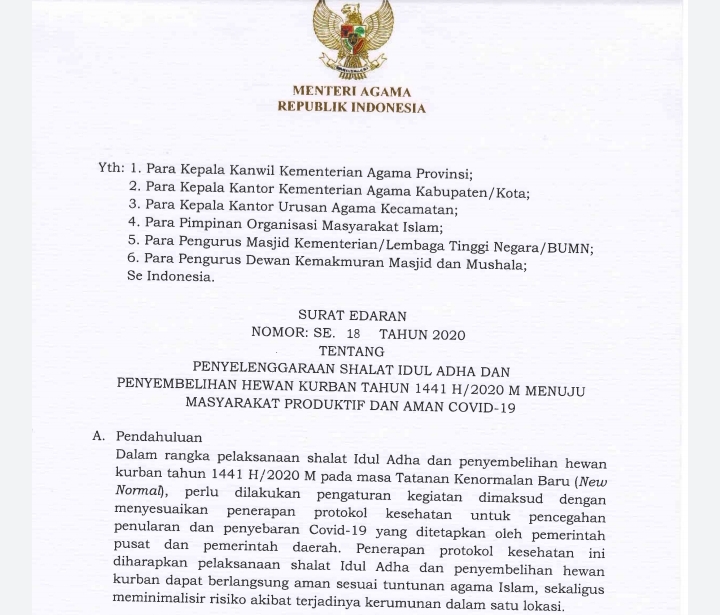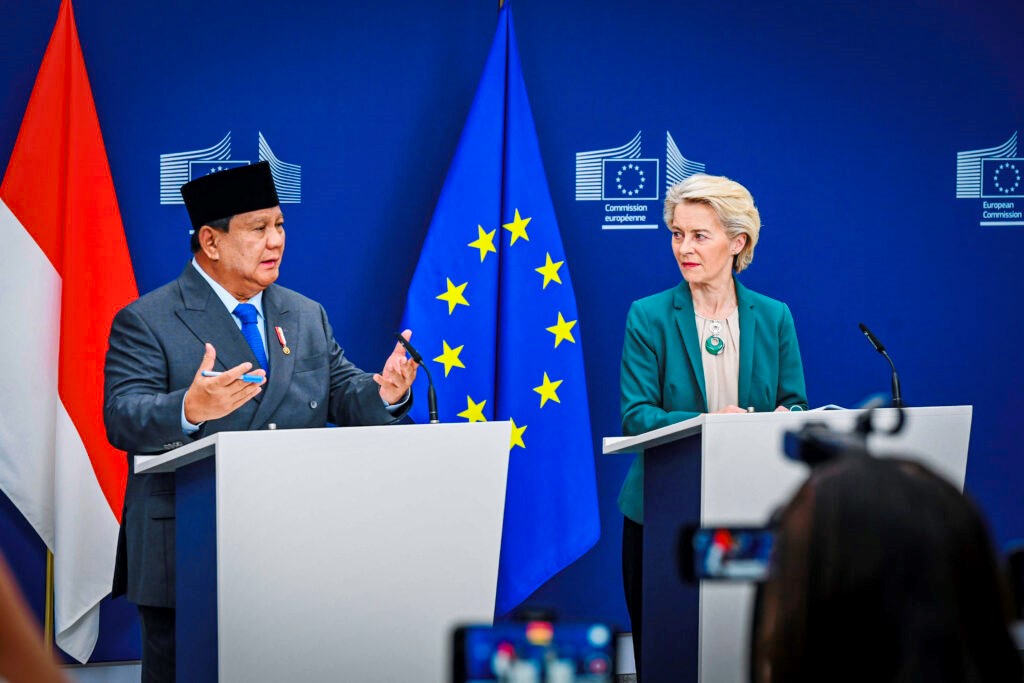Religious Affairs Ministry Issues Circular Number 18 of 2020 on Eid al-Adha

Circular Number 18 of 2020 issued by Minister of Religious Affairs on Organizing Eid al-Adha Prayer and the Slaughter of Sacrificial Animals of 1441H/2020M towards Productive and COVID-19 Safe Society.
The Indonesian Government through Ministry of Religious Affairs issued Circular Letter Number 18 of 2020 on Organizing Eid al-Adha Prayer and the Slaughter of Sacrificial Animals of 1441H/2020M towards Productive and COVID-19 Safe Society.
“This circular is expected to be a guideline for the application of health protocols for the implementation of Eid al-Adha prayers and the slaughtering of sacrificial animals by adjusting the implementation of the new normal order. That way, the Eid al Adha prayer and the slaughter of sacrificial animals can run optimally and safe from COVID-19 transmission,” Minister of Religious Affairs Fachrul Razi who signed the Circular on 30 June 2020 stated in Jakarta, Tuesday (30-6).
According to the Minister, the Eid prayer and the slaughter of sacrificial animals can be carried out in all regions, except in places deemed unsafe from COVID-19 by the Regional Governments/Regional Task Forces.
To implement both activities, the organizers must also pay attention to health protocols and coordinate with the Regional Governments.
The Eid prayer can be carried out in a field/mosque/room with the following requirements:
- Preparing officers to conduct and supervise the implementation of health protocols in the venue;
- Cleaning and disinfecting the venue;
- Limiting the number of entrance and exit doors/lanes to the location in order to ease the implementation and supervision of health protocols;
- Providing handwashing/soap/hand sanitizer facilities at the entrance and exit doors/lanes;
- Providing temperature checking devices at the entrance doors/lanes. If any of the congregation are found to have a temperature > 37.5’C (2 checks with a gap of 5 minutes), the person is not permitted to enter the area of the venue;
- Applying distance restrictions by giving a special mark of at least 1-meter distance;
- Shorten the implementation of Eid prayers and sermons without reducing the prayer conditions and pillars;
- Not accomodating moving box donations/alms to avoid disease transmission;
- The organizers appealed to the public about the health protocols for the implementation of Eid prayer which includes:
1) The congregation must be in good health;
2) Bring their own prayer mat;
3) Wearing facemasks since leaving the house and while in the venue;
4) Maintaining cleanliness of hands by frequently washing hands using soap or applying hand sanitizer;
5) Avoiding physical contacts, such as shaking hands or hugging;
6) Maintaining a minimum distance of 1 (one) meter between people;
7) Urging children and elderly citizens who are susceptible to contracting the disease, as well as people with diseases who are at high risk of COVID-19, to not attend the Eid prayer.
For the slaughter of sacrificial animals, the implementation must meet the following requirements:
- Applying physical distancing, including:
1) The slaughter of sacrificial animals is carried out in an area that allows the implementation of physical distance;
2) The organizers regulate the density at the slaughter location, only attended by the committee and the party who offers the sacrificial animals;
3) Adjusting the distance between the committees when cutting, skinning, chopping and packing the meat;
4) The distribution of sacrificial meat is done by the committee to the mustahiq (deserver)’s house.
- Assuring cleanliness of committee personnel, including:
1) Initial health check, which is measuring the body temperature at each entrance door/lane to the slaughtering venue with a temperature measuring device done by the officer;
2) The committee in the area of slaughtering and meat handling must separate the meat from the bones as well as the innards;
3) Each committee that carries out slaughter, skinning, chopping, packing, and distribution of animal meat must wear masks, long-sleeved clothing, and gloves while in the slaughtering area;
4) The Organizers should always educate the committee not to touch their eyes, nose, mouth, and ears, and often wash their hands with soap or apply hand sanitizer;
5) The committee should avoid shaking hands or having direct contact, and implement the ethics of coughing/sneezing/spitting;
6) The committee in the area of slaughter must clean themselves (take a bath) before meeting family members.
- Assuring the cleanliness of the tools, including:
1) Cleaning and disinfecting all tools before and after use, as well as cleaning the area and tools after the entire slaughter procession is completed;
2) Implementing a one person one tool system. If under certain conditions a committee must use other tool then it must be disinfected before use.
“The dissemination of information and supervision of the health protocol implementation as regulated in this circular will be carried out by the Provincial Office of Ministry, the Regency/Municipal Office of Ministry of Religious Affairs, and the District Office of Religious Affairs together with agencies in charge of animal health, and related agencies,” the Minister said. (Ministry of Religious Affairs PR/EN)
Translated by: Fairuzzamani Inayatillah
Reviewed by: Mia M. Bonaedy








